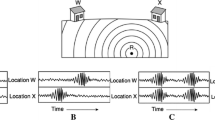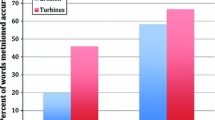Abstract
This report describes an inquiry-based Earth systems curriculum and strategies for teaching diverse students, which were embedded in the curriculum. The curriculum was implemented with 5th-grade students with varied linguistic, cultural, and socioeconomic backgrounds in five schools in a large, southeastern U.S., urban school district. At the end of the school year, all schools showed statistically significant improvement on two assessments: (1) an Earth systems unit test and (2) a sample of National Assessment of Educational Progress (NAEP) and Third International Mathematics and Science Study (TIMSS) items. Students’ perspectives regarding the cognitive and affective domains of the curriculum are discussed as are implications of the findings and recommendations for future research.
Similar content being viewed by others
References
Aikenhead, G. S. (2001). Integrating western and aboriginal sciences: Cross-cultural science teaching.Research in Science Education, 31(3), 337–355.
Aikenhead, G. S., & Jegede, O. J. (1999). Cross-cultural science education: A cognitive explanation of a cultural phenomenon.Journal of Research in Science Teaching, 36(3), 269–287.
Amaral, O., Garrison, L., & Klentschy, M. (2002). Helping English learners increase achievement through inquiry based science instruction.Bilingual Research Journal, 26(2), 213–239.
August, D., & Hakuta, K. (Eds.). (1997).Improving schooling for language-minority children: A research agenda. Washington, DC: National Academy Press.
Banks, J. A., & McGee Banks, C. A. (Eds.). (1997).Multicultural education: Issues and perspectives. Boston: Allyn & Bacon.
Barba, R. H. (1993). A study of culturally syntonic variables in the bilingual/bicultural science classroom.Journal of Research in Science Teaching, 30, 1053–1071.
Biological Sciences Curriculum Study. (1989).New designs for elementary school science and health: A cooperative project of Biological Sciences Curriculum Study (BSCS) and International Business Machines (IBM). Dubuque, IA: Kendall/Hunt.
Bredderman, T. (1983). Effects of activity-based elementary science on student outcomes: A quantitative synthesis.Review of Educational Research, 53(4), 499–518.
Carrier, K. A. (2005). Supporting science learning through science literacy objectives for English language learners.Science Activities, 42(2), 5–11.
Chamot, A. U. (1983). Toward a functional ESL curriculum in the elementary school.TESOL Quarterly, 17, 459–471.
Chamot, A. U., & O’Malley, J. M. (1994).The CALLA handbook: Implementing the cognitive academic language learning approach. Reading, MA: Addison-Wesley.
Council of Chief State School Officers (CCSSO). (1992).Recommendations for improving the assessment and monitoring of students with limited English proficiency. Washington, DC: Author.
Cummins, J. (1981). The role of primary language development in promoting educational success for language minority students. In C. F. Leyba (Ed.),School and language minority students: A theoretical framework (pp. 3–49). Los Angeles: Evaluation Dissemination and Assessment Center, California State University, Los Angeles.
Cummins, J. (2001).Negotiating identities: Education for empowerment in a diverse society. Los Angeles: California Association for Bilingual Education.
Dobb, F. (2004).Essential elements of science instruction for English learners (2nd ed.). Los Angeles: California Science Project.
Donahue, D., Evans, K., & Galguera, T. (2005).Rethinking preparation for content area teaching: The reading apprenticeship approach. Hoboken, NJ: West Ed and Jossey-Bass.
Echevarria, J., Vogt, M. E., & Short, D. (2004).Making content comprehensible for English learners: The SIOP model. Boston: Allyn & Bacon.
Fellows, N. J. (1994). A window into thinking: Using student writing to understand conceptual change in science learning.Journal of Research in Science Teaching, 31, 985–1001.
Fradd, S. H., Lee, O., Sutman, F. X., & Saxton, M. K. (2002). Materials development promoting science inquiry with English language learners: A case study.Bilingual Research Journal, 25(4), 479–501.
Freeman, Y. S., Freeman, D. D., & Mercuri, S. (2002).Closing the achievement gap: How to reach limited-formal-schooling and long-term English learners. Portsmouth, NH: Heinemann.
García, E. E. (1999).Student cultural diversity: Understanding and meeting the challenge (2nd ed.). Boston: Houghton Mifflin Company.
Gibbons, P. (2003). Mediating language learning: Teacher interactions with ESL students in a content-based classroom.TESOL Quarterly, 37(2), 247–273.
Golnick, D., & Chin, P. C. (2002).Multicultural education in a pluralistic society (6th ed.) New York: Merrill Prentice Hall.
Jones, R. M. (1985). Teaming up.Science and Children, 22(8), 21–23.
Kessler, D., Quinn, M. E., & Fathman, A. K. (1992). Science and cooperative learning for LEP students. In C. Kessler (Ed.),Cooperative language learner: A teacher’s resource book (pp. 65–83). Englewood Cliffs, NJ: Prentice Hall.
Krashen, S. D. (1982).Principles and practice in second language acquisition. London: Pergamon Press.
Ladson-Billings, G. (1994).The dreamkeepers: Successful teachers of African American children. San Francisco: Jossey-Bass.
Lambert, J., Lester, B., Lee, O., & Luykx, A. (2007). An Earth systems inquirybased approach reshapes teachers’ beliefs about instruction of diverse students. In D. B. Zanduliet (Ed.).Sustainable communities, sustainable environments. Rotterdam, The Netherlands: Sense Publishers.
Lee, O. (2002). Science inquiry for elementary students from diverse backgrounds. In W. G. Secada (Ed.),Review of research in education (Vol. 26, pp. 23–69). Washington, DC: American Educational Research Association.
Lee, O. (2003). Equity for culturally and linguistically diverse students in science education: A research agenda.Teachers College Record, 105(3), 465–489.
Lee, O., Deaktor, R., Enders, C., & Lambert, J. (2008). Impact of a multi-year professional development intervention on science achievement of culturally and linguistically diverse elementary students.Journal of Research in Science Teaching, 45(6), 726–747. [Under revision]
Lee, O., & Fradd, S. H. (1998). Science for all, including students from non-English language backgrounds.Educational Researcher, 27(3), 12–21.
Luykx, A., & Lee, O. (2007). Measuring instructional congruence in elementary science classrooms: Pedagogical and methodological components of a theoretical framework.Journal of Research in Science Teaching, 44(3), 424–447.
Maatta, D., Dobb, F., & Ostlund, K. (2006). Strategies for teaching science to English leanners. In A. K. Fathman & D. T. Crowther (Eds.),Science for English language learners: K-12 classroom strategies. Arlington, VA: National Science Teachers Association Press.
Matthews, C. E., & Smith, W. S. (1994). Native American related materials in elementary science instruction:Journal of Research in Science Teaching, 31(4), 363–380.
Mayer, V. (2002).Global science literacy. Dordrecht, The Netherlands: Kluwer Academic Publishers.
Miles M. B., & Huberman, A. M. (1984).Qualitative data analysis: A sourcebook of new methods. Beverly Hills, CA: Sage.
Moje, E., Collazo, T., Carillo, R., & Marx, R. W. (2001). “Maestro, what is quality?”: Examining competing discourses in project-based science.Journal of Research in Science Teaching, 38(4), 469–495.
National Research Council (NRC). (1996).National science education standards. Washington, DC: National Academy Press.
NRC (2000).Inquiry and the national science education standards: A guide for teaching and learning. Washington, DC: National Academy Press.
Ninnes, P. (2000). Representations of indigenous knowledges in secondary school science textbooks in Australia and Canada.International Journal of Science Education, 22(6), 603–617.
Powell, R. R., & Garcia, J. (1985). The portrayal of minorities and women in selected elementary science series.Journal of Research in Science Teaching, 22(6), 519–533.
Pratt, H., & Pratt, N. (2004). Integrating science and literacy instruction with a common goal of learning science content. In E. W. Saul (Ed.),Crossing borders in literacy and science instruction: Perspectives on theory and practice. Arlington, VA: National Science Teachers Association Press.
Rosebery, A. S., Warren, B., & Conant, F. R. (1992). Appropriate scientific discourse: Findings from language minority classrooms.The Journal of the Learning Sciences, 21, 61–94.
Short, D. (1991).How to integrate language and content instruction: A training manual. Washington, DC: Center for Applied Linguistics.
Snively, G., & Corsiglia, J. (2001). Discovering indigenous science: Implications for science education.Science Education, 85(1), 6–34.
Thier, H. D., & Daviss, B. (2001).Developing inquiry-based science materials: A guide for educators. New York: Teachers College Press.
Thier, M., & Daviss, B. (2002).The new science literacy: Using language skills to help students learn science. Portsmouth, NH: Heinemann.
Valadez, J. (2002).Dispelling the myth: Is there an effect of inquiry-based science teaching on standardized reading scores? Paper presented at the Second Annual Conference on Sustainability of Systemic Reform.
Westby, C., Dezale, J., Fradd, S. H., & Lee, O. (1999). Learning to do science: Influences of language and culture.Communication Disorders Quarterly, 21(1), 50–64.
Author information
Authors and Affiliations
Corresponding author
Additional information
This work is supported by the National Science Foundation, U.S. Department of Education, and National Institutes of Health (Grant No. REC-0089231). Any opinions, findings, conclusions, or recommendations in this publication are those of the authors and do not necessarily reflect the position, policy, or endorsement of the funding agencies.
Rights and permissions
About this article
Cite this article
Lambert, J., Ariza, E.N.W. Improving achievement for linguistically and culturally diverse learners through an inquiry-based earth systems curriculum. J Elem Sci Edu 20, 61–79 (2008). https://doi.org/10.1007/BF03173677
Accepted:
Issue Date:
DOI: https://doi.org/10.1007/BF03173677




